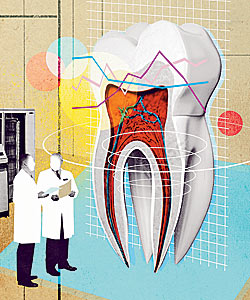
For anyone who has ever lost a tooth—including the 25 percent of Americans over 65 who have lost all theirs due to decay or gum disease—it may be possible to get natural replacements someday, thanks to breakthroughs being made at the University of Illinois at Chicago. On the fourth floor of the school’s College of Dentistry, researchers are inducing lab rats to form new dentin to fill cavities in their choppers. It’s the first step toward the holy grail of dentistry: regrowing teeth. Eventually people may be able to get replacement teeth—even a whole set of 32—made of human dentin and enamel and attached to the jaw with human fibers (rather than the titanium posts used today).
To create those new teeth, researchers are attacking the problem layer by layer, attempting “to copy how nature has done it,” says Anne George, professor of oral biology at UIC. George and her ten-member team of students and scientists are focusing on ways to produce dentin, the part-mineral, part-protein material inside teeth that provides cushioning during chewing. They drill a hole in a rat’s tooth and fill the cavity with a protein that attracts cells that make dentin. “It’s best to get cells to do the work,” she says. “What we are trying to do is see what molecules will help us repair and make new dentin.” George predicts that within five to ten years people will be able to generate their own natural fillings.
Related:
MORE MEDICAL NEWS
With Help from Rats, NU Neuroscientist Closes In on Depression Treatment
Chicago Researchers Discover Benefits of Hormone Replacement Therapy
Rush Sleep Center Doc: Fewer People Getting Enough Sleep
What We Know, and Don’t Know, About Concussions
New Hope For Men With Prostate Cancer
New Pill Offers Alternative for Skin Cancer Care
Sports Medicine Doctors Offer Tips to Avoid and Treat Injuries
On the same floor where George works, Thomas Diekwisch, head of oral biology and orthodontic research at UIC, is growing gums and enamel, the harder-than-bone substance that forms the outer layer of a tooth. It’s made of crystals arrayed in a picket-fence-like structure that “prevents the enamel from splintering while providing sufficient hardness,” he explains.
Diekwisch has already grown frog and cow enamel in lab mice and is also developing ways to attach teeth. He is implanting new teeth in rats—or putting back their old ones—using so-called progenitor cells that can grow into dental tissues, including pulp, dentin, and ligaments, and can even re-form lost tissues. He and his team have already successfully replanted teeth in 35 rodents. Within five years, he expects he will be able to use cells to reattach human teeth, which eventually could end the need for dentures for millions of Americans.
For people with tooth troubles today, dentists are already using materials and techniques that might once have seemed like science fiction. They fill cavities with tooth-colored composite resins instead of silver. For implants, some dentists are putting in crowns made of new high-strength ceramics, making it easier to achieve “excellent cosmetics,” says David Shonberg, a board-certified prosthodontist in Chicago. Conventional fixed bridges (false teeth cemented onto adjacent ones) and dentures—usually made from acrylic or composite resin—are more comfortable and look more natural than in the past.
Meanwhile, back at UIC, George envisions a day when implants, bridges, dentures, and the like will no longer be necessary. The next phase of research: raising crops of new teeth. Tissue engineers could figure out how to replicate the signals that tell the body to grow a new set of teeth. Or they could make new teeth in the lab by creating a scaffold that provides a sponge in which cells can grow. The trick: “It’s not so easy to re-create the shape of the natural tooth,” says Diekwisch. Eventually dentists would move these new pearly whites to a patient’s mouth, where it might take a month or so for them to fasten themselves.
What folks at UIC can’t say is exactly when some of these developments will migrate from the lab to the dental office. “There’s a big difference between being able to do it theoretically and a practical application,” says Diekwisch. “It’s very hard to predict this field.”
Illustration: Mario Wagner


